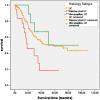Plasmacytoid variant of bladder cancer defines patients with poor prognosis if treated with cystectomy and adjuvant cisplatin-based chemotherapy
- PMID: 23394492
- PMCID: PMC3572418
- DOI: 10.1186/1471-2407-13-71
Plasmacytoid variant of bladder cancer defines patients with poor prognosis if treated with cystectomy and adjuvant cisplatin-based chemotherapy
Abstract
Background: Since the definition of different histologic subtypes of urothelial carcinomas by the World Health Organization (WHO) 2004 classification, description of molecular features and clinical behavior of these variants has gained more attention.
Methods: We reviewed 205 tumor samples of patients with locally advanced bladder cancer mainly treated within the randomized AUO-AB05/95 trial with radical cystectomy and adjuvant cisplatin-based chemotherapy for histologic subtypes. 178 UC, 18 plasmacytoid (PUC) and 9 micropapillary (MPC) carcinomas of the bladder were identified. Kaplan Meier analysis and backward multivariate Cox's proportional hazards regression analysis were performed to compare overall survival between the three histologic subtypes.
Results: Patients suffering from PUC have the worst clinical outcome regarding overall survival compared to conventional UC and MPC of the bladder that in turn seem have to best clinical outcome (27.4 months, 62.6 months, and 64.2 months, respectively; p=0.013 by Kaplan Meier analysis). Backward multivariate Cox´s proportional hazards regression analysis (adjusted to relevant clinicopathological parameters) showed a hazard ratio of 3.2 (p=0.045) for PUC in contrast to patients suffering from MPC.
Conclusions: Histopathological diagnosis of rare variants of urothelial carcinoma can identify patients with poor prognosis.
Figures




References
-
- Ferlay J, Parkin DM, Steliarova-Foucher E. Estimates of cancer incidence and mortality in europe in 2008. J Cancer. 2010;46(4):765–781. - PubMed
-
- Eble JSG, Epstein JI, Sesterhenn IA, editor. Classification of tumours. Pathology and genetics of the tumours of the urinary system and male genital organs. Lyon: World Health Organization; 2004.
-
- Keck B, Stoehr R, Wach S, Rogler A, Hofstaedter F, Lehmann J, Montironi R, Sibonye M, Fritsche HM, Lopez-Beltran A. et al.The plasmacytoid carcinoma of the bladder–rare variant of aggressive urothelial carcinoma. Int J Cancer Journal International du Cancer. 2011;129(2):346–354. doi: 10.1002/ijc.25700. - DOI - PubMed
-
- Amin MB, Ro JY, el-Sharkawy T, Lee KM, Troncoso P, Silva EG, Ordonez NG, Ayala AG. Micropapillary variant of transitional cell carcinoma of the urinary bladder. Histologic pattern resembling ovarian papillary serous carcinoma. Am J Surg Pathol. 1994;18(12):1224–1232. doi: 10.1097/00000478-199412000-00005. - DOI - PubMed
Publication types
MeSH terms
Substances
LinkOut - more resources
Full Text Sources
Other Literature Sources
Medical

